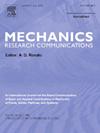Energy-based versus stress-based material failure criteria: The experimental assessment
IF 2.3
4区 工程技术
Q3 MECHANICS
引用次数: 0
Abstract
Previous studies have reported fracture localization within the inclusions of 3D-printed staggered composites, despite their significantly higher strength compared to the matrix – a seemingly counterintuitive phenomenon. In this letter, we investigate whether material failure is governed by the volumetric energy of fracture rather than the maximum stress criterion. We perform experiments on the constituent phases of 3D-printed staggered composites to evaluate the validity of energy-based failure criteria. Our findings support the idea that the work of fracture, rather than strength, governs failure. Specifically, at relatively higher strain rates, the ability of the soft matrix to absorb more energy before failure suggests that fracture localization is driven by energy considerations rather than stress thresholds. This aligns with previous observations that inclusions may fail before the matrix despite their higher strength. More broadly, since engineering materials often exhibit a crystalline molecular structure where failure is dictated by the energy required to break atomic and molecular bonds, it naturally follows that the work of fracture – rather than strength – should serve as the primary failure criterion. Our results reinforce this perspective, offering a more physically grounded approach to predicting material failure.
基于能量与基于应力的材料失效标准:实验评估
先前的研究报道了3d打印的交错复合材料的夹杂物中的断裂局部化,尽管它们的强度比基体高得多,这似乎是一种违反直觉的现象。在这封信中,我们研究了材料的破坏是否由断裂的体积能而不是最大应力准则控制。我们对3d打印交错复合材料的组成相进行实验,以评估基于能量的失效标准的有效性。我们的研究结果支持这样的观点,即断裂的作用,而不是力量,决定了失败。具体来说,在相对较高的应变速率下,软基质在破坏前吸收更多能量的能力表明,断裂局部化是由能量因素驱动的,而不是应力阈值。这与先前的观察一致,即包裹体可能在基体之前失效,尽管它们的强度更高。更广泛地说,由于工程材料通常表现为晶体分子结构,其破坏是由破坏原子和分子键所需的能量决定的,因此自然地,断裂功——而不是强度——应该作为主要的破坏标准。我们的研究结果加强了这一观点,提供了一种更基于物理的方法来预测材料失效。
本文章由计算机程序翻译,如有差异,请以英文原文为准。
求助全文
约1分钟内获得全文
求助全文
来源期刊
CiteScore
4.10
自引率
4.20%
发文量
114
审稿时长
9 months
期刊介绍:
Mechanics Research Communications publishes, as rapidly as possible, peer-reviewed manuscripts of high standards but restricted length. It aims to provide:
• a fast means of communication
• an exchange of ideas among workers in mechanics
• an effective method of bringing new results quickly to the public
• an informal vehicle for the discussion
• of ideas that may still be in the formative stages
The field of Mechanics will be understood to encompass the behavior of continua, fluids, solids, particles and their mixtures. Submissions must contain a strong, novel contribution to the field of mechanics, and ideally should be focused on current issues in the field involving theoretical, experimental and/or applied research, preferably within the broad expertise encompassed by the Board of Associate Editors. Deviations from these areas should be discussed in advance with the Editor-in-Chief.

 求助内容:
求助内容: 应助结果提醒方式:
应助结果提醒方式:


